Prostate enlargement is more common than most people think. It represents a health issue that does not only affect your lifestyle, but it also exposes one to considerable health risks and possible complications.
It is a health issue that each man should be informed about. And that is the exact purpose of this article. Well, that and the use of yoga to help you combat prostate enlargement symptoms.
What is BPH?
Before we go on explaining what prostate enlargement or BPH is and how to treat it using yoga. First, we need to share some information on the topic of what the prostate gland is.
The prostate gland is a small, endocrine gland that is found only in the male reproductive system. It is located around the urethra, between the bladder and the penis.
This muscular gland helps the production of semen. Its characteristic muscular structure allows it to stimulate the movement of the semen during ejaculation. Having a healthy prostate is essential for the male urinary system, but also reproductive health.
So, what is BPH? BPH, short for benign prostate hyperplasia, is a condition that characterizes with abnormal enlargement of the prostate gland. It is described as the most common prostate problem among men, along with prostate cancer. BPH symptoms usually take place after the age of 40.
Get Your FREE PSA Lowering Diet Plan!
- Naturally lower PSA levels
- Reduce nighttime trips to the bathroom
- Enjoy better bladder control and urine flow
What causes BPH?
What causes BPH? Statistics show that up to 85% of the men older than 85 years struggle with an enlarged prostate. In the US alone, benign prostatic hyperplasia affects as much as 14 million men. On a global level, the number of cases reaches 30 million.
Age
Prostate enlargement is suggested to occur naturally as a result of the normal aging process. This would explain the high number of cases worldwide, especially among men after the age of 80. The exact cause of BPH remains unknown. However, researchers think that it develops due to the combination of the aging process and the hormonal changes that take place during this life period.
As you probably know, men start to experience hormonal changes as soon as they reach the age of 30. What happens is a decline in their testosterone levels. But the side-effects of these hormonal changes are not evident up to the age of 50. It is then that men start to experience erectile dysfunction, loss of muscle mass, hair loss, weight gain, etc. due to their reduced testosterone levels.
Diabetes
Certain health issues such as type 2 diabetes and cardiovascular problems increase the risk of an enlargement of the prostate tissue. Having a poor diet and a sedentary lifestyle with a lack of physical activity also play a big role in developing this issue.
Family History
Having a family history of an enlarged prostate increases the risk of experiencing the same issue yourself. Certain health issues such as prostate cancer and prostatitis are known to cause an enlarged prostate as well.
Both prostate cancer and chronic prostatitis are serious health issues that harm the prostate health. Prostatitis represents an inflammation of the prostate gland, whereas prostate cancer causes abnormal prostate cancer cells’ abnormal growth. Prostate cancer is marked as the second-leading cause of death due to cancer among men.
Speaking about the symptoms of BPH, it is common for the patient to experience mild symptoms at the beginning. It is not until the later stages of the enlarged prostate gland that the symptoms become more severe. Understandably, many BPH treatment options slow down the progress of prostate disease.
Because of the close proximity between the prostate gland and the bladder, a wide range of urinary symptoms takes place. What happens is an obstruction to the normal urine flow to which several symptoms follow.
BPH Symptoms
These are the most common symptoms of benign prostatic hypertrophy:
- A sudden urge to urinate without being able to wait
- Frequent urination
- The urge to urinate a couple of times in the middle of the night, also known as nocturia
- Presence of blood in the urine
- Presence of pain during urination
- Disruption of the urinary
- Urinary incontinence
It is not uncommon for men to ignore the symptoms at first. It is only after their condition has worsened that the majority of patients ask for help. In this case, treatment is a must.
Proper treatment can eliminate most of the symptoms and improve the quality of life. In the case of prostate cancer being the cause of BPH, prostate cancer treatment can not only treat the prostate enlargement, but it will also slow down the progress of cancer itself.
Avoiding treatment will allow the condition to progress. It also exposes the patient to a number of serious complications. The list includes urinary tract infection, urinary stones, and even kidney damage, among others. Treatment usually includes a combination of lifestyle changes, medications, and physical activity. Patients also like to rely on natural herbal remedies used as well.
In more severe cases, surgery may be required. The most common surgical procedure is transurethral resection. During a transurethral resection (TURP), the surgeon eliminates a part of the prostate gland to free up space around the bladder and the urethra.
A prostate artery embolization is preferred since it is a minimally invasive procedure. A doctor uses a catheter that is inserted in the urethra to inject tiny microspheres to help reduce the blood supply to the prostate.
How might yoga help?
There is no denying the numerous scientific studies on the benefits of yoga. This ancient practice focuses on improving every aspect of our life, focusing on our health. Both mental and physical health can and will benefit from regular yoga practice.
So it is no surprise that yoga can help you beat prostate enlargement (BPH). For starters, yoga will help strengthen the pelvic floor muscles. This can contribute to significantly reducing the symptoms. You can expect your bladder control to improve, thus resulting in less aggravated BPH symptoms.
One important aspect of yoga for prostate enlargement is stress reduction. Not a lot of people know that stress is a great risk factor for BPH. Being constantly stressed out will only make the urinary symptoms worse. Yoga has also been shown to lessen treatment-related symptoms in men with prostate cancer.
Reducing your stress levels through yoga is an easy and effective way to feel better and more relaxed. If this sounds unbelievable, we encourage you to look at a study published in the International Journal of Yoga.
Yoga poses for BPH
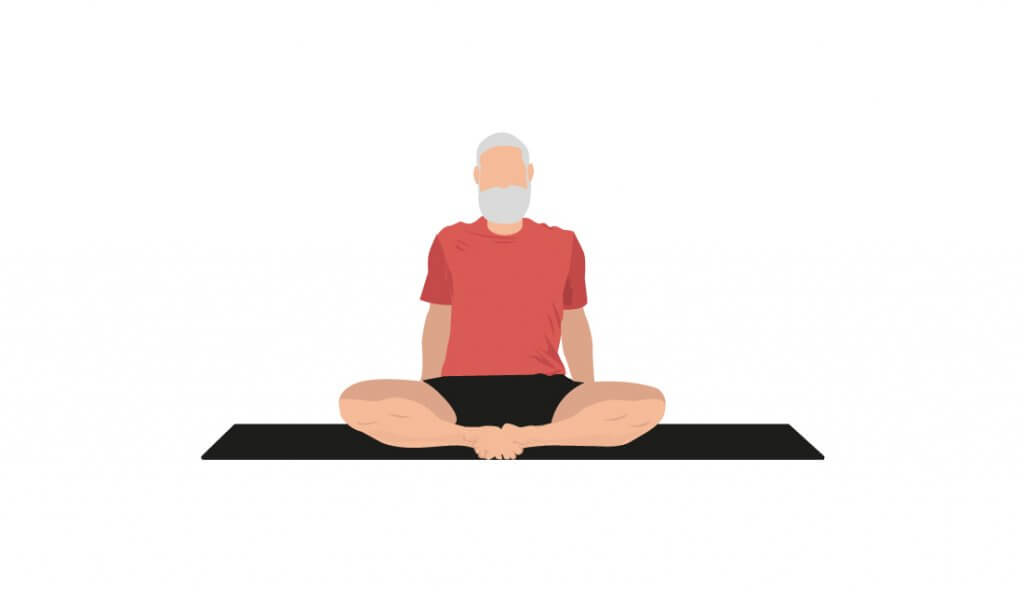
1) The Cobbler Pose (Baddha Konasana)
The Cobbler pose, also known as the butterfly stretch, is one of BPH’s easiest yoga poses. It is designed to help relieve pelvic tension. It is done in a seated position. And, it is recommended for those who are new to yoga that they use a cushion or a mat that they will sit on.
To do the Cobbler pose, start by sitting down on the floor with the legs extended in front of you. Bend the knees to the sides and place the soles of the feet so that they are touching. Use your hands to clasp the feet and hold them together. The goal is to lower the knees closer to the floor as much as possible. Try to maintain this pose for a few minutes, then walk the hands in front of your legs if available to you. Remember to breathe the entire time deeply.
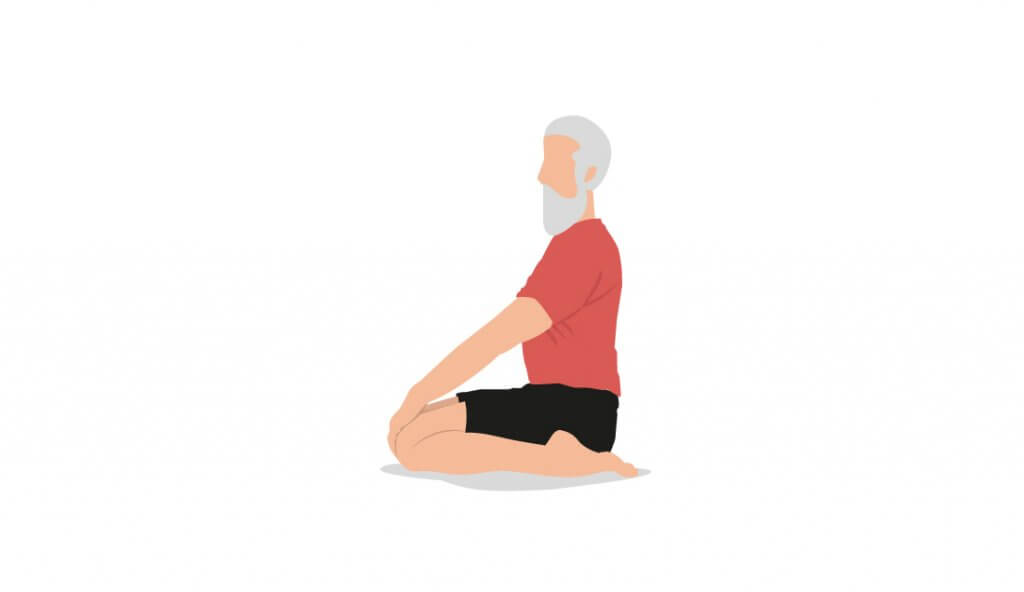
2) The Hero pose (Virasana)
Yet another seated position to help you lower the pelvic tension is the Hero pose. To get in this pose, sit down on the floor so that you are sitting between your feet. The toes should be pointing backward, and the knees should touch the ground. If this is unavailable to you, use a cushion that you can sit on for extra support. Lengthen your spine as much as possible and keep your head up. Stay in this pose for a couple of minutes while taking deep breaths.
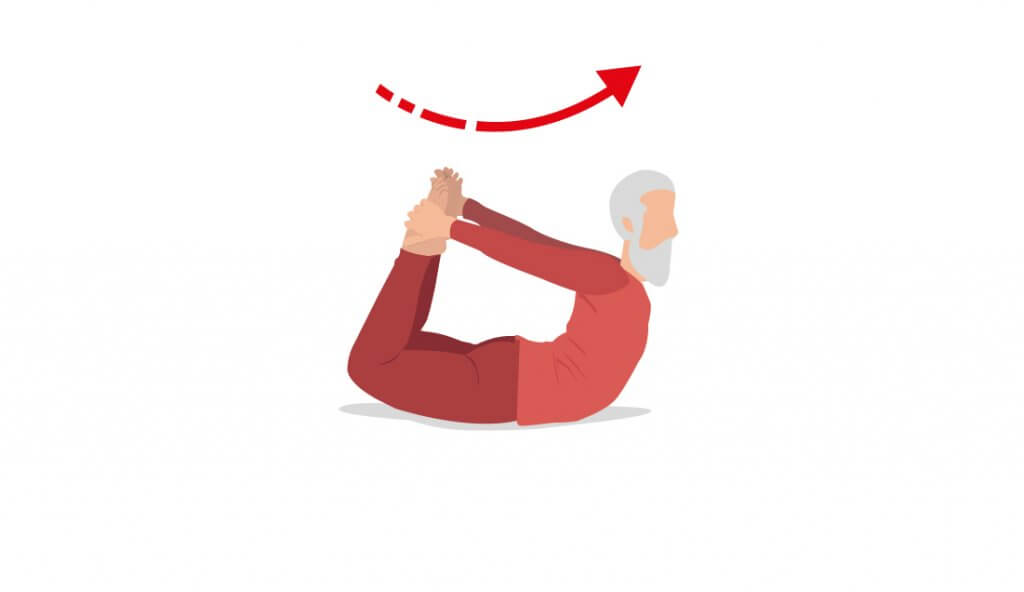
3) The Bow pose (Dhanurasana)
Switch things up a bit by getting into the Bow pose. The Bow pose is done by lying on your stomach. This will help strengthen your pelvic floor muscles and your abdominal muscles and the muscles on the lower back.
Lay on your stomach with your hands extended by your side. Bend your knees and start to lift your legs from the floor. At the same time, start raising your head and chest upwards by using your hands to grab the ankles. You can also hold your shins or your feet, whichever feels more comfortable. Keep breathing and looking in front of you. Stay in this pose for up to 30 seconds, then lower your body and repeat.
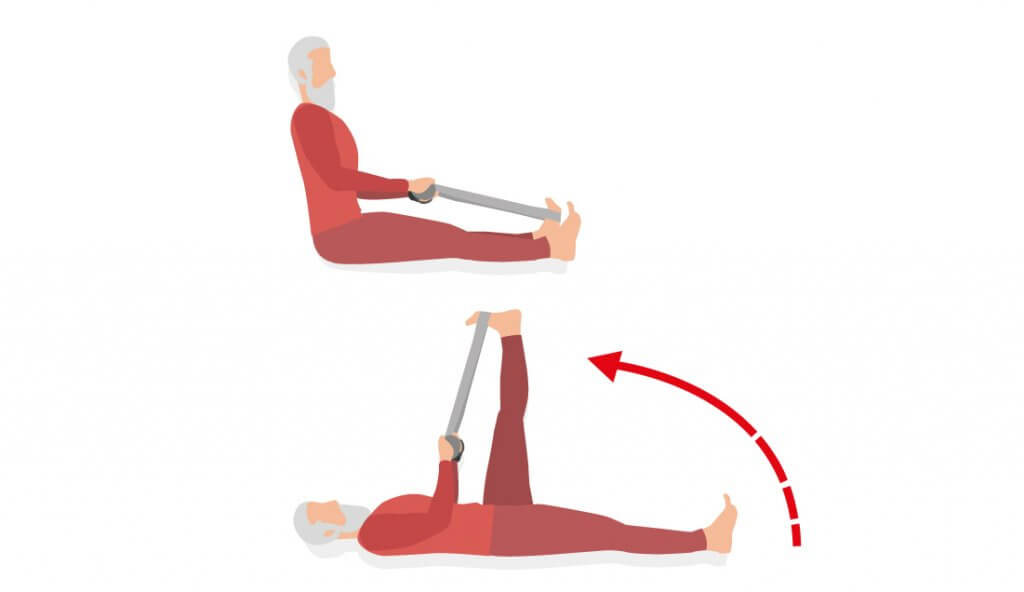
4) The Reclining hand-to-big toe pose (Supta Padangusthasana)
After you are done doing the Bow pose, turn to your back for the famous Reclining hand-to-big toe pose. This is a great yoga pose for prostate enlargement because it strengthens the pelvic floor muscles, and it releases tension all at the same time.
Lie on your back and extend your legs completely. Then bend one knee and move your thigh closer to your chest. Keep your other leg extended on the floor and point your toes for stability. Put a stretching strap on the toes of your bent leg. Slowly strengthen the leg and flex the foot, holding onto the strap. Move the leg as close as possible to your body, while keeping it straight. Take deep breaths and keep in this pose for a couple of seconds. Then repeat using your other leg.
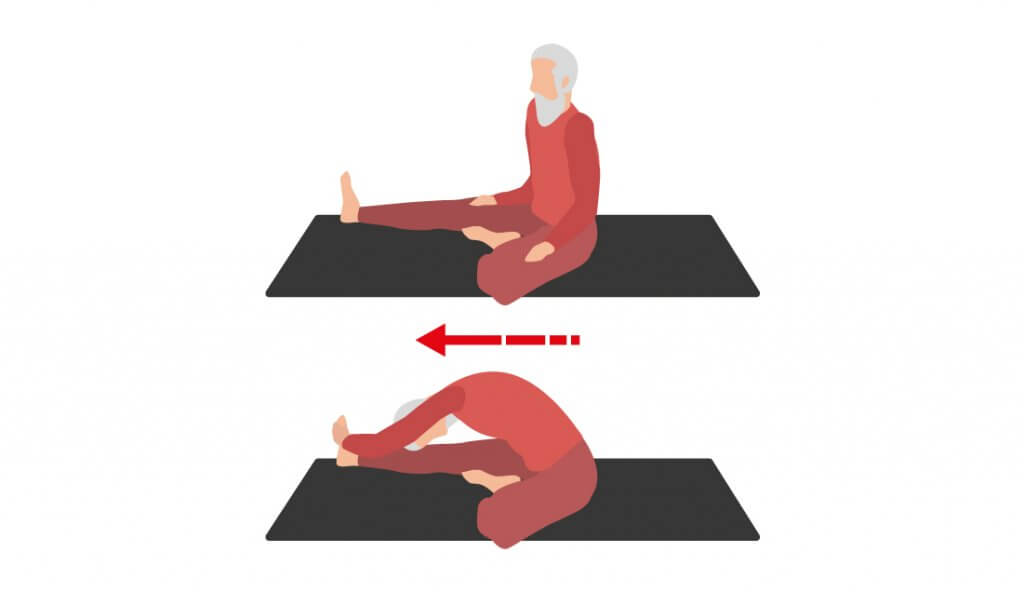
5) The Head-to-knee pose (Janusirsasana)
If you want to release tension and strengthen your core simultaneously, we recommend doing the Head-to-knee pose. It is said that doing this pose on a regular basis will help improve the blood flow to the pelvis as well as detoxify it.
Start by sitting down and extending your legs in front of you. Bend one knee and bring the sole of the foot to touch the thigh on the other side. Keeping the other leg extended, walk your hands to the front. Start bending towards the extended leg.
Beginners will feel the urge to bend the knee of the extended leg and even round their spine. This is okay, and it is just another yoga goal to work towards. Stay in this pose a couple of seconds and use your breath to relax. Then repeat on the other side.
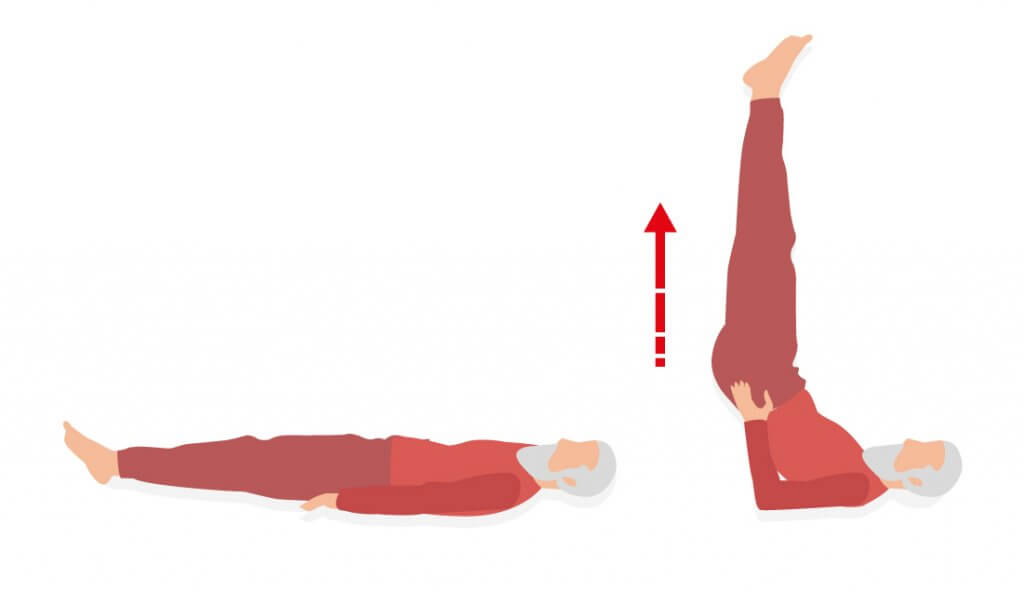
6) The Shoulder stand (Biparitkarani Mudra)
The Shoulder stand is one of the more advanced yoga poses. You are advised against making a full Shoulder stand at the beginning of your training. Of course, you are always welcome to work towards it. This is an amazing pose that allows strengthening the pelvic floor muscles, lower back, and abdominals and improving the overall health of the prostate.
To get into a Shoulder stand, you first need to lie on your back. Start to raise your legs, using your abdominals and lower back muscles to support the movement.
Eventually, your hips will need to come off the mat and leave only your head and shoulders on the ground. For beginners, it is recommended that they also use their hands to support their lower bodies. This is known as a supported shoulder stand.
Other exercises for BPH
Other than yoga, other forms of physical activity may be beneficial in the treatment of prostate enlargement. Since we are speaking of urinary incontinence, the best exercises out there would be Kegel exercises. For anyone unfamiliar with these exercises, do read carefully.
Kegel exercises are specially designed exercises to help you train your pelvic floor muscles. Despite being most commonly used among women after pregnancy, these exercises have been proven useful in other occasions.
The good news is that they are relatively simple and easy to do, and they do not require any special equipment. They can also be done anywhere in just a few short minutes. Doing them regularly will help you strengthen the pelvic floor muscles and eliminate the lower urinary tract symptoms.
First, you need to locate your pelvic floor muscles. The best time to do that is while urinating. As soon as you start urinating, stop the flow. Now repeat that by focusing on the muscles that have allowed you to do that. These are the muscles that you need to train.
Now that you know which muscles we are talking about, you are free to repeat these exercises a couple of times per day. Start by tightening them for up to three seconds and then relaxing them for the next three seconds. Repeat the movement a few times. When you feel comfortable, do increase the time.
Other than Kegel exercises, you can also try any other type of exercise. From jogging, running, cycling, doing a home workout, or going to the gym, the choice is yours. The important thing is to keep moving. This will allow you to lose any extra weight, which will help you to lower the risk of any additional prostate problems.
Conclusion
Facing BPH is not a pleasant nor comfortable experience. It is an issue that promises to make every aspect of your life harder simply by affecting that small gland hidden within the bladder and the urethra.
If you are tired of getting up at night and experiencing frequent urinary infections, we encourage you to make a change today. Trying something as simple as yoga can make significant changes for prostate enlargement, ones that will finally put a stop to your suffering. What’s your favorite yoga pose? Let us know in the comments!
Next Up








